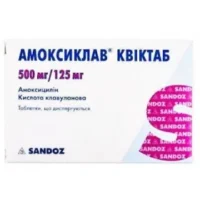Description
Flemoxin (Amoxicillin) Soliutab Tablets 500 mg. №20
Ingredients
Each tablet contains 500 mg of amoxicillin.
Mechanism of Action
Amoxicillin, a semisynthetic penicillin, inhibits bacterial cell wall synthesis by binding to penicillin-binding proteins, thus disrupting the bacterial cell wall formation and leading to bacterial cell death.
Pharmacological Properties
Amoxicillin exhibits bactericidal activity against a wide range of gram-positive and gram-negative bacteria. It is well-absorbed after oral administration and reaches therapeutic concentrations in various tissues and body fluids.
Indications for Use
Flemoxin Soliutab tablets are indicated for the treatment of bacterial infections, including respiratory tract infections, urinary tract infections, skin and soft tissue infections, and more.
Contraindications
Do not use Flemoxin Soliutab tablets if you are allergic to penicillin or have a history of severe allergic reactions to beta-lactam antibiotics. Consult a healthcare provider before use to assess the risk of hypersensitivity reactions.
Side Effects
Common side effects of amoxicillin may include gastrointestinal disturbances, allergic reactions (such as rash or itching), and rarely, severe skin reactions. Inform your healthcare provider if you experience any adverse effects.
Usage Instructions
Take 1 tablet (500 mg) of Flemoxin Soliutab every 8 hours. Swallow the tablet whole with a full glass of water. Follow the dosage instructions provided by your doctor based on the severity of the infection.
Benefits Compared to Analogues
Flemoxin Soliutab offers the advantage of convenient dosing with its solubility in water, making it suitable for patients who have difficulty swallowing solid tablets. The formulation ensures consistent delivery of amoxicillin for effective treatment of bacterial infections.
Suitable Patient Groups
Flemoxin Soliutab is suitable for adults, children, and elderly patients. Dosage adjustments may be necessary in patients with renal impairment. Consult a healthcare provider for personalized dosing recommendations.
Storage and Shelf Life
Store Flemoxin Soliutab tablets in a cool, dry place away from moisture and sunlight. Check the expiration date on the packaging and do not use the product beyond the stated shelf life.
Packaging Description
Flemoxin Soliutab tablets are typically packaged in blister packs to ensure individual tablet protection and maintain product integrity. Each pack contains 20 tablets of 500 mg strength.
Scientific Evidence
Amoxicillin has been extensively researched and proven effective in the treatment of various bacterial infections. Clinical studies have demonstrated the high efficacy of amoxicillin in respiratory tract infections, supporting its use as a first-line antibiotic therapy.
Additional Information
Complete the full course of treatment with Flemoxin Soliutab tablets as prescribed by your healthcare provider to maximize therapeutic benefits and minimize the risk of antibiotic resistance development. Inform your doctor about any medical conditions or medications to prevent potential drug interactions.





